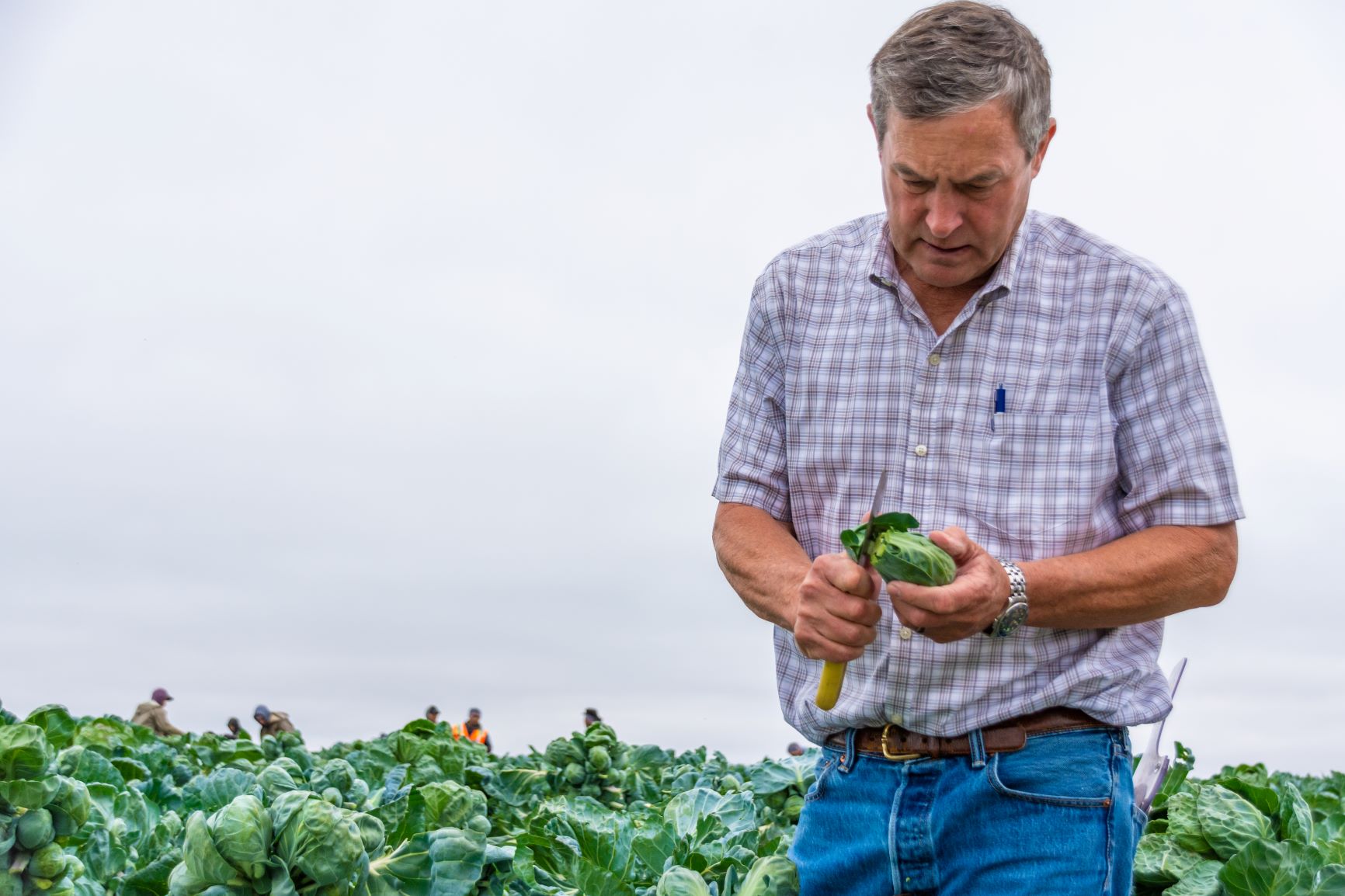Brussels sprouts nab more acreage as demand grows

The Brussels sprouts that farmers grow today no longer taste bitter thanks to breeding efforts through the years to produce sweeter varieties.The trendy vegetable has become a culinary superstar, with farmers ramping up production to meet growing demand.
Photo/Courtesy of Hitchcock Farms

By Linda DuBois
As Brussels sprouts have become trendy on social media and restaurant menus during the past several years, California farmers have been able to cash in on the vegetable’s popularity.
“The market’s really grown, especially the fresh market, and a lot of that has to do with the food shows on TV and chefs’ artistic abilities,” said Monterey County-based vegetable grower Jeff Hitchcock. “It’s really put Brussels sprouts on the map.”
U.S. per capita consumption of Brussels sprouts increased from 0.33 pounds in 2011 to 0.78 pounds in 2019, according to U.S. Department of Agriculture statistics.
The hike in demand has prompted farmers such as Hitchcock to boost production. The initial 25 acres he planted in 2014 has grown to 500 acres in Monterey County, 300 in San Mateo County and 250 in Mexico to accommodate year-round production.
Hitchcock, who is also a packer and shipper of fresh produce, said his company’s Brussels sprout business has “evolved immensely in 10 years.”
“Now, we sell millions of cartons a year to processors and partner buyers,” he added.
The sprouts ultimately end up on retail grocery shelves and in restaurants across the country.
The Rodoni family, who’s been growing Brussels sprouts on the Central Coast since 1935, began seeing a spike in demand around 2014.
“That’s when we looked at how we could become a year-round producer in California and added a Ventura County farm,” said Alex Rodoni, who now grows seven varieties for the fresh and frozen markets.
He harvests Brussels sprouts from July through January in Monterey and Santa Cruz counties, May through November in San Luis Obispo County and late January through mid-June in Ventura County.
Rodoni said the rising demand plateaued around 2020-21 but has remained strong, especially during the holiday season.
“It averages out to about an 80% uptick for us during November and December,” Rodoni said.
Norm Groot, Monterey County Farm Bureau executive director, said he has noticed a significant increase in Brussels sprout production in his area.
“During the last few years, we’ve seen a lot more fields planted in Brussels sprouts, particularly in the coastal zone area, where typically you see artichokes, strawberries and lettuce,” Groot said, adding he’s also noticed Brussel sprouts showing up on more local restaurant menus.
Groot said he has witnessed similar trends before when “you start having a lot of social media posts and influencers talking about a particular crop and different ways to prepare it. It happened in the past with cauliflower and with kale. So, now we’re seeing it with Brussels sprouts.”
Crop report statistics support Groot’s observations about Monterey County’s Brussels sprout boom.
In 2022, Monterey County’s Brussels sprout production was valued at nearly $115 million, accounting for 60.7% of California’s gross value of more than $189 million, according to the California Department of Food and Agriculture. Following Monterey were San Luis Obispo County at 13.5% with more than $25.4 million; Santa Barbara County at 7.8% with nearly $15 million; Santa Cruz County at 7.1% with nearly $13.4 million; and Ventura County at 6.1% with more than $11.5 million.
Compare this to 2014 when not only did Brussels sprouts fail to make the top crop list on the county crop report, but they were lumped in with 17 “miscellaneous vegetables.” Then in 2015, Brussels sprouts debuted on Monterey County’s top crop list at No. 20 with a crop value of nearly $31.3 million, and by 2020, the vegetable ranked No. 8, with its value peaking at nearly $116.3 million.
By 2023, the crop’s value was ranked No. 11 and valued at more than $107.3 million, down from the previous year but still up more than $76 million from 2015.
Last year’s decrease could be evidence that the market is leveling off, but the numbers are likely influenced by 2023’s extreme weather conditions. That year saw heavy rains with flooding and unseasonably hot and cold spells that hurt yields, Rodoni noted.
So far, things are looking better this year for Rodini and Hitchcock, they said, with summer through winter yields on track to be higher than last year’s.
The Central Coast normally has the ideal conditions for Brussels sprouts, with moderate temperatures and moist, well-drained, medium to heavy soil.
“I would say about 40 to 80 degrees is their temperature point, but it also depends on their stage of growth,” Rodoni said. Young plants tolerate heat well, “but as they get older, the milder the temperature you have, the better. …Their sweet spot is having about a 10- to 12-degree temperature swing. That’s when they grow the best.”
Growing Brussels sprouts comes with a few challenges. “Insects love Brussels sprouts,” Hitchcock said.
This is especially true on his Ventura County farm, Rodoni said, with the top pest being Diamondback moth larvae. “It never gets cold enough in Southern California to break their growth cycle,” he said.
Brussels sprouts also are a slow-growing crop, starting in a greenhouse for two months before they’re transplanted and grow another 150 to 160 days before harvest, Hitchcock said.
“They tie up a lot of ground for a long time for a single crop,” he said, adding this also leaves more time for pests or bad weather to affect them.
Rodini said the slow cycle also requires planning far ahead. “I have planting schedules done through the fall of 2025,” he said. This makes it tricky to balance supply with demand, he added.
Due to all the variables, the profit margin for Brussels sprouts is typically “slim” but sustainable, Rodini said.
He and Hitchcock said they are optimistic the market will stay strong for the foreseeable future.
Today, people are more conscientious about eating healthful food than they used to be. Plus, the Brussels sprouts commercially grown today taste better than the bitter varieties most adults ate as children and are gaining new fans, they noted.
About 30 years ago, a Dutch scientist first identified the chemicals, called glucosinolates, that made Brussels sprouts bitter, and breeders began working to produce sweeter varieties. The early results were delicious but low-yield plants. Breeders crossed them with more prolific plants until they found ones that made tasty sprouts with decent yields.
Rodoni said he hopes more people will start viewing Brussels sprouts as an everyday vegetable and not just a holiday item.
“We hope there’s a sustainable balance where we don’t see waves of influx and decrease throughout the year,” he said.
(Linda DuBois is assistant editor of California Bountiful magazine. She may be reached at ldubois@cfbf.com.)




